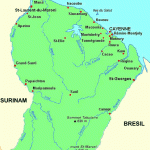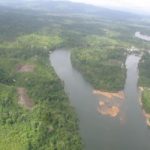
Fostering research excellence
in EU Outermost Regions

Fostering research excellence
in EU Outermost Regions

French Guiana is located 7500 km from Paris. With an area of 83846 km², this territory counts 262527 as 3 hab / km².
Most of the population major rivers borders while the interior of the territory is sparsely populated.
French Guiana, the European land in the Amazon, contributes greatly to the national and European balance of biodiversity and carbon.
Indeed, one hectare of Amazon rainforest is the equivalent of the biodiversity of all of continental Europe. For example, this represents 98% of vertebrates and 96% of vascular plants in France.
Hence the importance of the work carried out by research organizations on the knowledge and protection of Amazonian bioresources and of the interest of collaboration between Amazonian countries on the subject.

French Guiana is the only continental territory
of France and the European Union in South America.
High place of biodiversity and one of the richest in the world (animal and vegetable), half of French
biodiversity is in French Guiana : 29% of plants, 55% of higher vertebrates (mammals, birds, fish, etc.) and up to 92% of insects. All this in a single department of 86,504 km2.
As a space port of Europe, French Guiana
naturally turns to tele-applications with a particularity on the uses in isolated zone, taking into account the extent of the territory
French Guiana in a few words :
French Guiana has 296,711 inhabitants. It is the fastest growing population in France, and second least populated region of France behind Mayotte. In the West of the territory, the population is growing faster than in the agglomeration of Cayenne.
The population is increasing sharply : it could increase to 424,000 inhabitants in 2030, according to INSEE, if the trends observed from 1999 to 2009 continue, due to a high rate of natural growth (excess births on deaths) and under the effect of significant immigration from neighboring countries (Brazil, Guyana, Haiti, Suriname).
Resulting from discontinuous periods of strong immigration, the Guyanese population is cosmopolitan: in 2015, one inhabitant in three is of foreign nationality. Due to the youth of its population, French Guiana is the region with the lowest mortality rate. She is also the youngest after Mayotte, with one in two people under 25 years old. In French Guiana, 30% of families are single-parent families. This does not exclude that they are often large families.
The year 2018 continues the dynamic of economic recovery that began in the second half of 2017. In a favorable regional, national and international context, the implementation of the emergency plan provides additional guarantees of confidence to businesses to produce and invest, and to households to consume.
The space industry remains dynamic and invests to cope with intensifying competition. Although waiting, the construction sector is facing construction sites of importance for a few years.
As for the tourism sector is at its highest and the demographics still strong and demanding. Salaried employment is increasing in all sectors of activity, making it possible to lower the level of unemployment.
French Guiana is the only European department in the Amazon. This gives it a geographical particularity and an undeniable asset within the European Union.
To add, the research and innovation strategy is based on key areas called strategic action areas. They are now funded by the European Regional Development Fund and European Agricultural Fund for Rural DevelopmentOperational Programs by the European Commission through its Regional Innovation Strategy (SRI-SI).
As a result, these areas represent a real added value for the European Union and focus in particular on its rich biodiversity.